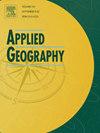经济复杂性和城市扩张在形成社会空间隔离在墨西哥的相互作用
IF 5.4
2区 地球科学
Q1 GEOGRAPHY
引用次数: 0
摘要
本研究探讨了墨西哥大都市区经济复杂性、城市扩张和社会空间隔离之间的相互作用。利用城市土地联系框架,我们概念化了经济结构和空间动态如何共同塑造不平等模式。利用秩序信息理论全球指数,我们量化了74个大都市地区的收入隔离,并评估了其与经济复杂性、低密度城市扩张和基础设施驱动的流动性模式的关系。将重点从国家层面的差异转移到大都市层面的动态,我们应用k -均值聚类(KMC)和普通最小二乘(OLS)模型来确定隔离的主要相关因素。我们的研究结果表明,随着专业化产业在地理上的集中,更高的经济复杂性与隔离程度的增加有关,从而加剧了空间不平等。同样,城市扩张——以分散的发展和依赖汽车的基础设施为特征——通过限制低收入人群的可达性,加剧了隔离。这些发现挑战了经济增长或多样化必然导致包容性城市发展的假设,而是强调了经济专业化和空间扩张在延续城市不平等方面的结构性作用。本文章由计算机程序翻译,如有差异,请以英文原文为准。
The interplay of economic complexity and urban sprawl in shaping socio-spatial segregation in Mexico
This study examines the interplay between economic complexity, urban sprawl, and socio-spatial segregation in Mexico's metropolitan areas. Drawing on the urban land nexus framework, we conceptualize how economic structures, and spatial dynamics jointly shape patterns of inequality. Using the Rank-Order Information Theory global index, we quantify income segregation across 74 metropolitan areas and assess its association with economic complexity, low-density urban expansion, and infrastructure-driven mobility patterns. Shifting the focus from national-level divides to metropolitan-level dynamics, we apply K-means clustering (KMC) and Ordinary Least Squares (OLS) models to identify the principal correlates of segregation. Our results show that higher economic complexity is associated with increased segregation, as specialized industries concentrate geographically, reinforcing spatial inequalities. Similarly, urban sprawl—characterized by dispersed development and car-dependent infrastructure—exacerbates segregation by limiting accessibility for lower-income populations. These findings challenge the assumption that economic growth or diversification inherently leads to inclusive urban development, highlighting instead the structural role of economic specialization and spatial expansion in perpetuating urban inequality.
求助全文
通过发布文献求助,成功后即可免费获取论文全文。
去求助
来源期刊

Applied Geography
GEOGRAPHY-
CiteScore
8.00
自引率
2.00%
发文量
134
期刊介绍:
Applied Geography is a journal devoted to the publication of research which utilizes geographic approaches (human, physical, nature-society and GIScience) to resolve human problems that have a spatial dimension. These problems may be related to the assessment, management and allocation of the world physical and/or human resources. The underlying rationale of the journal is that only through a clear understanding of the relevant societal, physical, and coupled natural-humans systems can we resolve such problems. Papers are invited on any theme involving the application of geographical theory and methodology in the resolution of human problems.
 求助内容:
求助内容: 应助结果提醒方式:
应助结果提醒方式:


